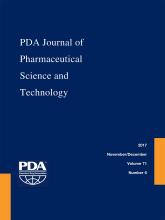Abstract
Water for injection is used in multiple applications in the biopharmaceutical industry. Regarding this, several methods have been use to generate water with this high quality. Within them, the thermocompression distillation method has been widely employed. However, reports on the maintenance of the qualification and validation status of thermocompression systems used for water for injection generation are non-existent in the scientific literature. Therefore, this paper sought to give results of continuous process verification of a system used for water for injection generation over 2 years analyzing the level of conductivity, nitrate, total organic carbon, endotoxins, and microbiology in 1284 water samples. The main findings were that conductivity and nitrate values were always below the specification limit defined according to the United States Pharmacopeia and European Pharmacopoeia, respectively. The highest total organic carbon value measured was 156 ppb. Regarding the microbiology results, the maximum endotoxin content detected was 0.063 EU/mL and 2 cfu/100 mL. In conclusion, this study demonstrated that the analyzed water for injection system operated under a validated status for 2 years, and it was supported by an appropriate monitoring program according to current process validation guidelines.
LAY ABSTRACT: There are multiple methods used to produce water for injection in the biopharmaceutical industry. The thermocompression distillation method has been one of the most used methods for the production of this high-quality water. Nevertheless, to verify maintenance of the validated state of these systems it is necessary to carry out continued process verification of different parameters such as conductivity, total organic carbon, limulus amebocyte lysate, and microbiology according to the mandatory requirements of the United States Pharmacopeia and the European Pharmacopoeia. Therefore, this article presents an example of the application of thermocompression technology to generate water for injection and evidence of continuous monitoring to allow demonstration of the efficiency and reliability of these systems used in the biotechnological industry.
- © PDA, Inc. 2017
PDA members receive access to all articles published in the current year and previous volume year. Institutional subscribers received access to all content. Log in below to receive access to this article if you are either of these.
If you are neither or you are a PDA member trying to access an article outside of your membership license, then you must purchase access to this article (below). If you do not have a username or password for JPST, you will be required to create an account prior to purchasing.
Full issue PDFs are for PDA members only.
Note to pda.org users
The PDA and PDA bookstore websites (www.pda.org and www.pda.org/bookstore) are separate websites from the PDA JPST website. When you first join PDA, your initial UserID and Password are sent to HighWirePress to create your PDA JPST account. Subsequent UserrID and Password changes required at the PDA websites will not pass on to PDA JPST and vice versa. If you forget your PDA JPST UserID and/or Password, you can request help to retrieve UserID and reset Password below.






